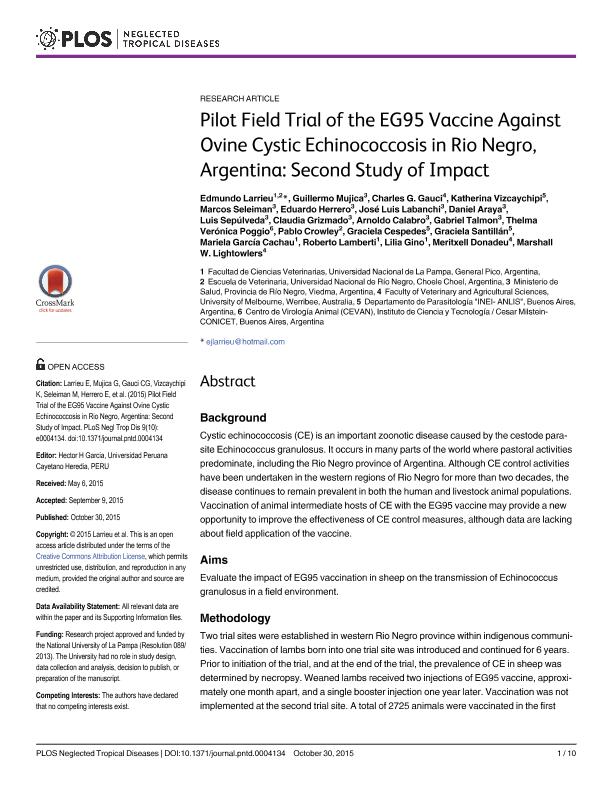Artículo
Pilot Field Trial of the EG95 Vaccine Against Ovine Cystic Echinococcosis in Rio Negro, Argentina: Second Study of Impact
Larrieu, Edmundo Juan; Mujica, Guillermo; Gauci, Charles G.; Vizcaychipi, Katherina; Seleiman, Marcos; Herrero, Eduardo; Labanchi, José Luis; Araya, Daniel; Sepúlveda, Luis; Grizmado, Claudia; Calabro, Arnoldo; Talmon, Gabriel; Poggio, Thelma Veronica ; Crowley, Pablo; Cespedes, Graciela; Santillán, Graciela; García Cachau, Mariela; Lamberti, Roberto; Gino, Lilia; Donadeu, Meritxell; Lightowlers, Marshall W.
; Crowley, Pablo; Cespedes, Graciela; Santillán, Graciela; García Cachau, Mariela; Lamberti, Roberto; Gino, Lilia; Donadeu, Meritxell; Lightowlers, Marshall W.
 ; Crowley, Pablo; Cespedes, Graciela; Santillán, Graciela; García Cachau, Mariela; Lamberti, Roberto; Gino, Lilia; Donadeu, Meritxell; Lightowlers, Marshall W.
; Crowley, Pablo; Cespedes, Graciela; Santillán, Graciela; García Cachau, Mariela; Lamberti, Roberto; Gino, Lilia; Donadeu, Meritxell; Lightowlers, Marshall W.
Fecha de publicación:
30/10/2015
Editorial:
Public Library of Science
Revista:
PLoS Neglected Tropical Diseases
ISSN:
1935-2735
Idioma:
Inglés
Tipo de recurso:
Artículo publicado
Clasificación temática:
Resumen
Cystic echinococcosis (CE) is an important zoonotic disease caused by the cestode parasite Echinococcus granulosus. It occurs in many parts of the world where pastoral activities predominate, including the Rio Negro province of Argentina. Although CE control activities have been undertaken in the western regions of Rio Negro for more than two decades, the disease continues to remain prevalent in both the human and livestock animal populations. Vaccination of animal intermediate hosts of CE with the EG95 vaccine may provide a new opportunity to improve the effectiveness of CE control measures, although data are lacking about field application of the vaccine. Aims: Evaluate the impact of EG95 vaccination in sheep on the transmission of Echinococcus granulosus in a field environment. Methodology: Two trial sites were established in western Rio Negro province within indigenous communities. Vaccination of lambs born into one trial site was introduced and continued for 6 years. Prior to initiation of the trial, and at the end of the trial, the prevalence of CE in sheep was determined by necropsy. Weaned lambs received two injections of EG95 vaccine, approximately one month apart, and a single booster injection one year later. Vaccination was not implemented at the second trial site. A total of 2725 animals were vaccinated in the first year. Animals from this cohort as well as age-matched sheep from the control area were evaluated by necropsy. Key results: Introduction of the vaccine led to a statistically significant in the number and size of hydatid cysts in comparison to the situation prior to the introduction of the vaccine, or compared to CE prevalence in the control area where the vaccine was not applied. The prevalence of infection in the vaccinated area was also significantly reduced by 62% compared to the re-intervention level, being lower than the prevalence seen in the control area, although the difference from the control area after the intervention was not significant possibly due to limitations in the numbers of animals available for necropsy. Conclusions: Vaccination of sheep with the EG95 vaccine provides a valuable new tool which improves the effectiveness of CE control activities. Vaccination was effective even in a difficult, remote environment where only approximately half the lambs born into the communities were fully vaccinated.
Palabras clave:
Echinococcosis Quistica
,
Vacuna Eg95
,
Ovinos
,
Ensayo a Campo
Archivos asociados
Licencia
Identificadores
Colecciones
Articulos(ICT - MILSTEIN)
Articulos de INST.DE CS. Y TECNOLOGIA "DR. CESAR MILSTEIN"
Articulos de INST.DE CS. Y TECNOLOGIA "DR. CESAR MILSTEIN"
Citación
Larrieu, Edmundo Juan; Mujica, Guillermo; Gauci, Charles G.; Vizcaychipi, Katherina; Seleiman, Marcos; et al.; Pilot Field Trial of the EG95 Vaccine Against Ovine Cystic Echinococcosis in Rio Negro, Argentina: Second Study of Impact; Public Library of Science; PLoS Neglected Tropical Diseases; 9; 10; 30-10-2015; 1-10
Compartir
Altmétricas



